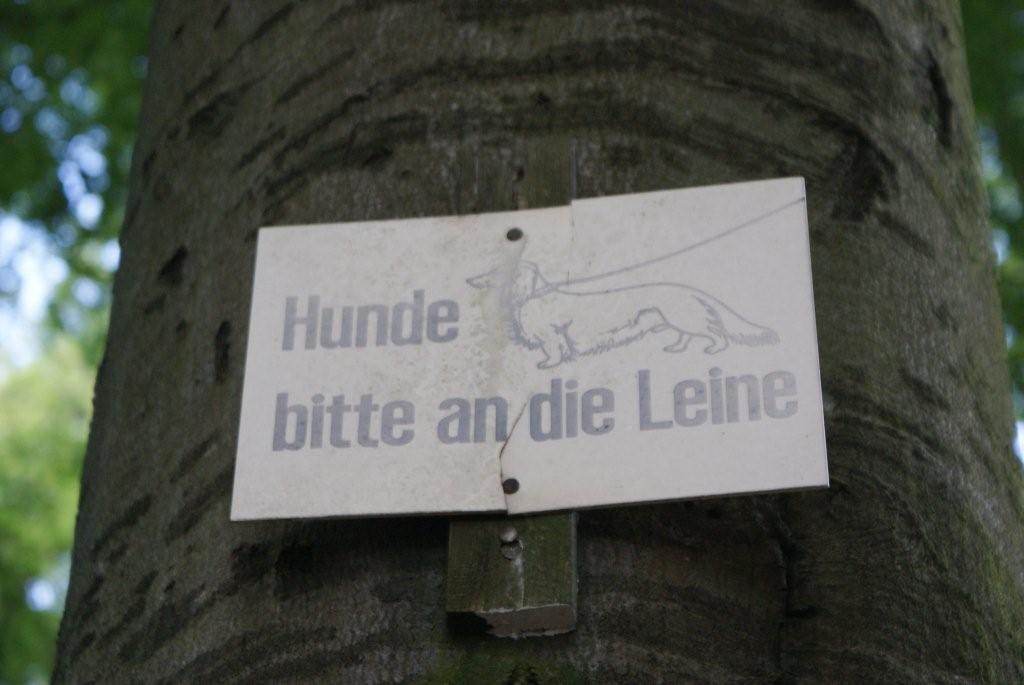3.12 Germans and their dogs
Man(n)'s best friend?
 The poster states proudly: "Wir gehören zusammen!" - "We belong together". And it is immediately apparent to the outsider that Germans adore their dogs. Cats are much less visible in German cities - there is a law which says they have to be kept in, and this is respected in Germany. Dogs, on the other hand, are taken everywhere. It's not unusual to see them in restaurants with their own water bowls supplied by the proprietor. This is in part because German dogs have traditionally been well-behaved - they all have to be registered and vaccinated against rabies (die Tollwut), as this is prevalent in many areas among wildlife. You will also see signs in every park pointing out the strict "pooper-scooper" laws and designating special areas for dogs to swim in so that the rest is more pleasant for human bathers. The poster states proudly: "Wir gehören zusammen!" - "We belong together". And it is immediately apparent to the outsider that Germans adore their dogs. Cats are much less visible in German cities - there is a law which says they have to be kept in, and this is respected in Germany. Dogs, on the other hand, are taken everywhere. It's not unusual to see them in restaurants with their own water bowls supplied by the proprietor. This is in part because German dogs have traditionally been well-behaved - they all have to be registered and vaccinated against rabies (die Tollwut), as this is prevalent in many areas among wildlife. You will also see signs in every park pointing out the strict "pooper-scooper" laws and designating special areas for dogs to swim in so that the rest is more pleasant for human bathers.

There are however several initiatives to help owners. Some parks or streets have a special area designated as a "Hundeklo" (= "doggy loo"). In popular dog-walking areas you will see vending machines (der Automat) for bags and scoops to get rid of mess, and bins are also provided. In Vienna, for example, certain areas are clearly designated as either "dog-free" (das Hundeverbot), "dog zones" (die Hundezone) or "a suitable place to walk your dogs" (der Hundeauslaufplatz).

Dog ownership however is one area in which the Germans are inclined to turn a blind eye to the regulations. John Hooper, Berlin correspondent for The Guardian
wrote: "There are more dogs in Berlin than in most of Germany's other big cities put together. And an astonishing number can be found off their leads, not just rambling in the parks, but ambling along pavements, lounging in cafes and bars, and even in restaurants and clubs. Even members of the most popular breed, the pit bull terrier, roam about unhindered, along with rottweilers, dobermans and other dogs that look as if they eat a poodle or two for breakfast."

Until the start of the new millennium, that is. The tragic death of a six-year-old Turkish boy in Hamburg at the hands of a pit-bull terrier and a Staffordshire terrier in July 2000 finally provoked the authorities into action after a growing number of children had been attacked by fighting dogs (der Kampfhund) ("fighting dogs"). Since then a number of measures have been introduced on a regional level to control how dangerous dogs are kept. These include stricter implementation of "der Leinenzwang", the requirement that certain dogs are kept on a leash in public, and the "der Maulkorbzwang", the requirement that certain dogs are muzzled. Some commentators have gone as far as to suggest that all dogs, regardless of breed, should be kept on a leash when out in public. And in Berlin, anyone owning pitbulls, American Staffordshire terriers, bull terriers or Tosa Inu must have them sterilised. These measure have proved unpopular with dog owners, and they are digging their heels in for a long battle with the authorities.
 |
Web Links |
 |
| Web sites on pets and other animals |
 |
German animal sounds |
Visit this site to find out which German animal goes "wau! wau!", and which goes "mähh, mähh". |
 |
German Embassy - Dangerous Dogs |
The German Embassy in London explains what legislation exists concerning dangerous dogs in Germany and why. |
 |
Capital letters |
John Hooper of The Guardian reports on his experiences of being a dog owner in Berlin. |
 |
German zoos |
Visit the homepages of zoos in German-speaking countries. |
 |
Virtual Zoo |
Visit a "virtual reality" zoo in Zurich. |
 |
Whiskas cat food |
Watch the adverts for Whiskas cat food on their homepage! |
 |
Die Tier-Seite |
A good thematic link-list of homepages devoted to German animals from Birgit Bachmann. In German only. |
|
 Chapter 3: Exercises Chapter 3: Exercises
 Nach oben Nach oben
 Print This Page Print This Page
|